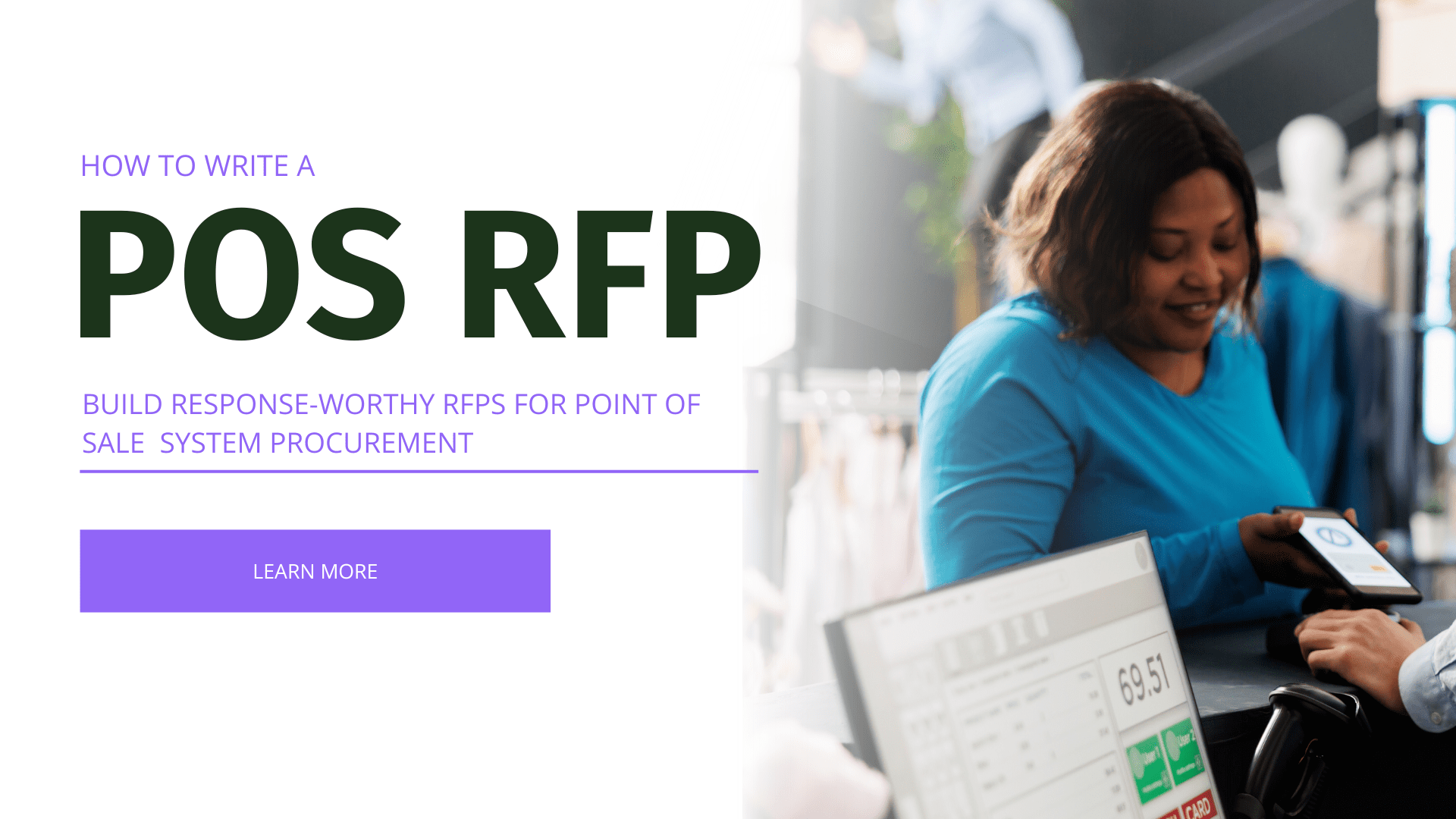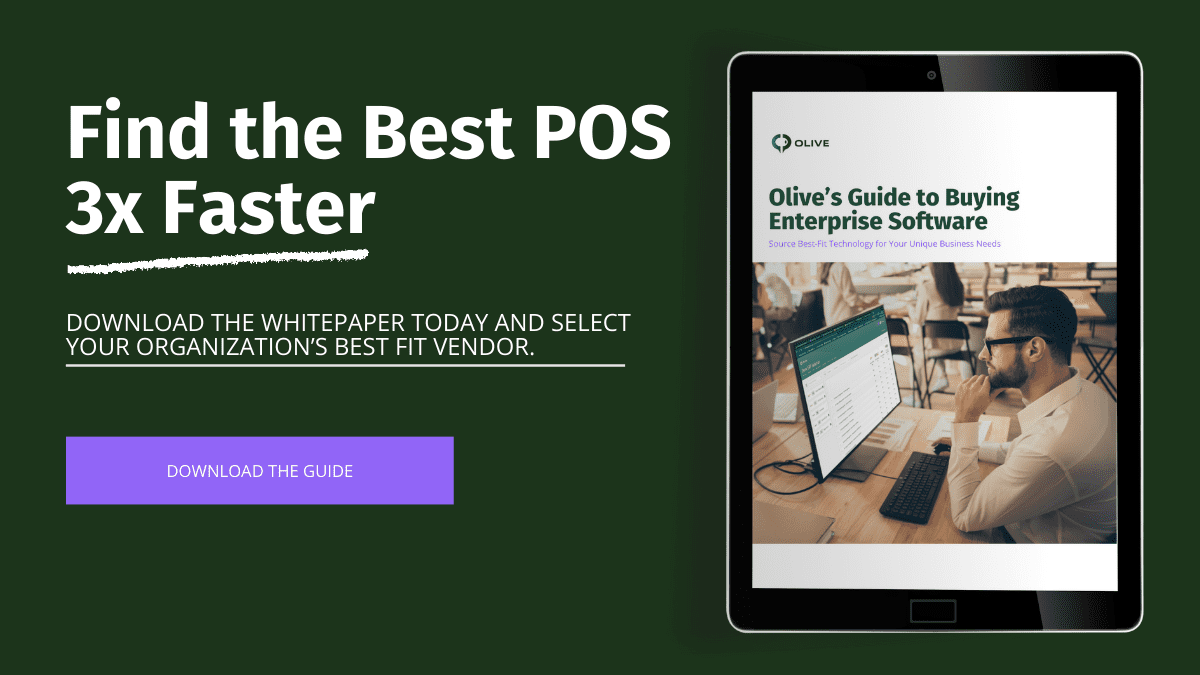Do You Have the Best POS Solution for Your Business Needs?
With so many POS software vendors on the market, picking the right one for your business can be overwhelming. Now, more than ever, leaders in the retail hospitality and restaurant industry must ensure they have a POS solution that works for their specific requirements. Furthermore, the POS system should integrate with existing platforms, like click-and-collect systems, in-store or restaurant pickup, delivery, and current API and eCommerce platforms.
Other considerations include how the POS might work with subscription-based services that reduce shopping trips and interactions, and even how a POS may connect to electronics and other devices that support home-based transactions and experiences.
At Olive, we aim to bridge the gap between buyers and sellers, and it is our mission to help you source the best POS software solution for your unique and evolving business needs. We believe the secret to finding the best POS is to lead with these business needs.
Unfortunately, current software procurement practices fail to deliver on their expected returns for many retail and hospitality industry CIOs seeking POS systems and other technology solutions. The process is lengthy and prone to bias. For this reason, many companies skip over carefully evaluating solutions against the business needs and go straight to demo and shortlisting. Often this results in POS solutions not meeting company expectations.
When sourcing POS vendors, it’s crucial to take a strategic approach to ensure the chosen solution aligns seamlessly with your business needs. In this blog post, we’ll delve into the key considerations for selecting the right Point of Sale (POS) solution, emphasizing the importance of understanding your unique business requirements.
The Complexity of Choosing the Right POS Solution
In the bustling landscape of Point of Sale software vendors, the multitude of choices can make the decision-making process daunting. The retail, hospitality, and restaurant industries, in particular, demand tailored solutions that go beyond just processing transactions. A holistic POS system should integrate with various platforms, such as click-and-collect systems, in-store or restaurant pickup, delivery services, and existing API and eCommerce platforms. For example, the best POS for a Restaurant Chain will be very different to the best POS for a Grocery Chain.
Beyond Transactions: Adapting to Changing Business Dynamics
In today’s rapidly evolving business landscape, the adaptability of a POS solution is paramount. Consider how the system accommodates subscription-based services, reducing physical interactions and enhancing customer convenience. Moreover, the ability of the POS to connect with various electronic devices, supporting not only in-store but also home-based transactions and experiences, is a vital aspect of future-proofing your business operations.
Olive’s Mission: Bridging the Gap
At Olive, our mission is to act as a conduit between buyers and sellers, facilitating the process of finding the best POS software solution tailored to your business needs. We firmly believe that the key to discovering the optimal POS solution lies in prioritizing your unique and evolving business requirements.
The Pitfalls of Hasty Procurement
Regrettably, many businesses fall victim to the pitfalls of hasty procurement practices when selecting POS solutions. Rushing through the evaluation process and skipping over a careful examination of solutions against business needs can lead to suboptimal choices. Simply relying on demos and shortlisting without a comprehensive understanding of your requirements often results in POS solutions that fail to meet company expectations.
A Strategic Approach to POS Vendor Selection
When sourcing POS vendors, it’s imperative to resist the urge to shortcut the evaluation process. Instead, take a strategic approach to ensure you choose a system that aligns with your specific business needs and goals.
1. Identify Your Needs and Goals
Simply searching for “Top POS platforms 2020” won’t yield results tailored to your unique requirements. The right POS for a grocery store chain is likely different from that of a hotel chain. Start by examining your business objectives, understanding your customer’s needs and behaviors, and using this information to define your POS system requirements.
2. Define and Rank Your POS Requirements
Once you have a clear understanding of your needs and goals, the next step is to articulate your specific POS requirements and prioritize them based on your business objectives. Engaging multiple stakeholders in this process ensures a comprehensive list of needs, which helps in identifying the best-fit solution for your organization.
3. Explore the Available Options
With your requirements defined, begin researching POS vendors. Traditionally, this involves reading reviews and testimonials on platforms like Capterra or G2Crowd. However, keep in mind that these platforms can be biased due to paid placements. Using a service like Olive, which does not charge vendors, can provide an unbiased shortlist of solutions.
4. Evaluate Vendors
After narrowing down to a shortlist of 3-5 vendors, request detailed use case examples and demonstrations. This step is crucial to see how each solution performs in real-world scenarios relevant to your business.
5. Make the Best Choice for Your Business Needs
In the final decision-making stage, ensure due diligence by thoroughly evaluating each option against your business’s specific needs and goals. Involve various stakeholders to gain multiple perspectives and mitigate the risk of bias.
The Importance of a Detailed POS RFP
Creating a detailed Request for Proposal (RFP) is an essential part of sourcing the best POS system. An RFP allows you to communicate your needs and expectations clearly to vendors, making it easier to compare solutions on a level playing field.
Key Steps in Creating a POS RFP:
- Outline Your Business Requirements: Clearly describe your business, its objectives, and the specific functionalities you need from a POS system. Include details about required integrations with existing systems, such as eCommerce platforms, inventory management systems, and any other relevant technology.
- Specify Technical and Functional Requirements: List the technical specifications, such as hardware compatibility, software features, and security requirements. Functional requirements should cover transaction processing, reporting, inventory management, and any industry-specific needs.
- Include Evaluation Criteria: Define how you will assess the responses. Criteria might include cost, ease of use, scalability, vendor reputation, and customer support.
- Request Detailed Proposals: Ask vendors to provide detailed information on their products, including case studies, client references, and detailed pricing structures. Request demos and trial periods to evaluate the solutions hands-on.
- Set a Timeline: Provide a clear timeline for the RFP process, including deadlines for questions, submission dates, and the decision-making timeline.
By following these steps, you can ensure a thorough and unbiased selection process that identifies the POS system best suited to your unique business needs. With Olive’s collaborative platform, you can streamline this process, ensuring all stakeholders are involved and all requirements are met without bias.
Finding the Right POS for Your Unique Business’s Needs can be an Efficient and Collaborative Process
Olive has helped companies like Freddy’s source the right POS Vendor for their needs. Olive takes the best process for procuring software and makes it easy for you to collaborate with your stakeholders to identify and rank your requirements. With Olive, you can anonymously review all the POS systems and integrations available in the space, within the context of how these POS systems meet your evolving business needs. Olive takes this long list of vendors and boils it down to a shortlist that is assured to meet your needs. Searching for POS reviews on Capterra or G2Crowd, can deliver biased results, but with Olive, we don’t charge vendors, so you can be confident that there is no bias on the shortlist.
With Olive, you can check out various project requirements ahead of time and easily filter out vendors based on these requirements. Easily filter out vendors who don’t meet your needs, and ensure the POS addresses new business concerns.








